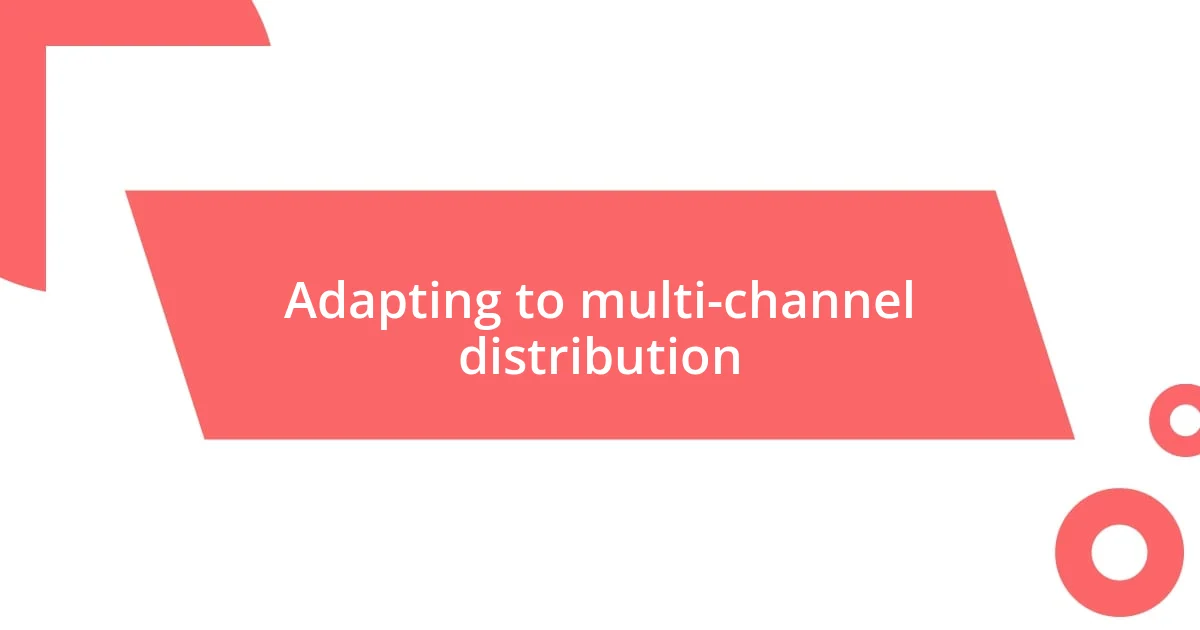Key takeaways:
- The rise of direct-to-consumer brands and a focus on customer relationships highlight the importance of transparency and connection in distribution.
- Technological advancements, including automation, mobile technology, and data analytics, are revolutionizing distribution efficiency and customer satisfaction.
- Future distribution strategies will prioritize sustainability, automation, and data-driven decision-making to meet changing consumer expectations and enhance brand loyalty.

Understanding distribution trends
To truly grasp distribution trends, it’s essential to delve into how consumer behavior has shifted over the years. I recall a time when the local store was the go-to place for purchases; now, online shopping has transformed our expectations significantly. Isn’t it fascinating how a simple click gives us access to products from around the globe, changing the whole landscape of distribution?
One notable trend I’ve observed is the rise of direct-to-consumer (DTC) brands. I remember when I first tried a DTC skincare line—buying directly from the source made me feel more connected to the brand. This shift emphasizes the importance of customer relationships and the desire for transparency in distribution. It makes me wonder: how much more could brands achieve by fostering that connection?
Furthermore, the increasing emphasis on sustainability is driving changes in distribution methodologies. I can’t help but feel a sense of responsibility when choosing eco-friendly options. Are companies adapting fast enough to meet this demand? Watching brands push for greener practices, whether through less packaging or efficient delivery routes, has inspired me. It’s a reminder that distribution trends aren’t just about logistics; they’re about values and ethics, shaping our world profoundly.

Impact of technology on distribution
The evolution of technology has dramatically reshaped distribution channels, making them more efficient and optimized. The introduction of automated warehouses is a perfect example. I remember visiting a facility where robots handled inventory with astonishing speed. Witnessing that blend of human ingenuity and machines in action sparked a realization: technology not only streamlines the process but also enhances accuracy and reduces errors, which is crucial for consumer satisfaction.
Mobile technology is another game-changer in distribution. I often find myself using apps to track shipments in real-time, which brings peace of mind. This immediate access to information allows businesses to respond quickly to customer inquiries and supply chain disruptions. It’s almost like having a digital assistant, ensuring everything stays on track, and I’m sure many can relate to that convenience.
Lastly, the rise of data analytics cannot be overstated. I’ve attended workshops where experts discussed how companies leverage data insights to predict demand effectively. The ability to analyze consumer behavior helps brands strategize their distribution methods. In my experience, businesses that embrace this technology stay ahead of the curve. They deliver products at the right time and place, truly revolutionizing the way we think about distribution.
| Technology Factor | Impact on Distribution |
|---|---|
| Automated Warehouses | Increased efficiency and reduced errors |
| Mobile Technology | Real-time tracking for improved customer service |
| Data Analytics | Enhanced demand forecasting and strategic planning |

Shifts in consumer behavior
Shifts in consumer behavior have been fascinating to witness. I remember shopping with my parents, where we’d spend hours browsing aisles. Now, it’s astonishing to see how consumers prefer the convenience of online shopping. That instant gratification from getting items delivered to our doorsteps has changed expectations dramatically. With just a few clicks, I can order anything, but it also feels like a lost art of savoring the shopping experience.
The shift towards personalized shopping experiences can’t be overlooked. I recall receiving a tailored recommendation after browsing a few items online—it felt like the brand was truly understanding my needs. This growing preference for curated experiences has led businesses to leverage AI and data, ensuring more relevant product suggestions. Here’s a bullet list summarizing key shifts in consumer behavior:
- Increased reliance on online shopping for convenience and immediacy
- Demand for personalization in marketing and product recommendations
- Preference for brands that showcase transparency and ethical practices
- Growing awareness of sustainability, influencing purchasing decisions
- Interest in social commerce, utilizing platforms like Instagram and TikTok for shopping

Adapting to multi-channel distribution
The necessity of adapting to multi-channel distribution is clearer than ever in today’s fast-paced market. I remember when I first noticed a brand seamlessly integrating its online store with physical locations. It was thrilling to walk into a shop, find a product I liked, and have the option to check its availability online, even while standing in the aisle. It really made me think about how important it is for businesses to create a cohesive experience that meets consumers where they are.
In my experience, multi-channel distribution isn’t just about having various outlets; it’s about understanding customer preferences across these channels. I often switch between my laptop and phone when shopping, depending on my mood or where I am. This constant back-and-forth highlights for me the need for brands to ensure their messaging and pricing remain consistent. It’s a challenge, but when done right, it creates loyalty—something I truly value as a consumer.
Moreover, I can’t stress enough how essential it is for businesses to listen to and respond to feedback across all platforms. There’s something gratifying about knowing my voice as a customer is heard. Just last month, I left a review for a service, and to my surprise, they reached out to address my concerns. This level of engagement not only enhances my trust in the brand but also emphasizes how adaptive and responsive multi-channel distribution can be in hitting the mark with customers. How often do you feel a brand is truly listening to you? Each interaction shapes their approach, reinforcing the need for a multi-faceted strategy.

Best practices for efficient distribution
Efficient distribution is really about understanding the intricacies of logistics and supply chains. I once visited a warehouse that used cutting-edge technology to manage inventory. It was fascinating to see how they could pinpoint exactly where every product was located, optimizing their operations in real time. This experience made me realize that investing in such technologies not only speeds up delivery but also enhances customer satisfaction. Have you ever experienced a delay due to logistics mishaps? It certainly makes you appreciate when things run smoothly.
Another best practice I’ve observed is fostering strong relationships with suppliers. I remember a small business owner sharing how a solid partnership with their suppliers allowed them to adapt quickly during peak seasons. This agility was key in ensuring that their products were always available when demand spiked. It made me think about how essential this level of collaboration is in today’s competitive landscape. Are your relationships with suppliers solid enough to withstand the market’s unpredictable shifts?
Lastly, ongoing training for staff involved in distribution cannot be overlooked. I’ve seen firsthand how a well-trained team can significantly reduce errors and improve efficiency. At a logistic firm I worked with, regular training sessions transformed their operations—turning a high-error rate into a model of precision. It reminded me that investing in human resources is just as critical as investing in technology. How well do you think your team is prepared for the ever-evolving demands of efficient distribution?

Future predictions for distribution strategies
Looking ahead, I believe that automation will play a pivotal role in revolutionizing distribution strategies. I recall visiting a fulfillment center where drones were being tested to deliver packages within local areas. The excitement I felt seeing technology at work made me realize that this could soon become a standard practice. As consumer expectations shift towards faster delivery times, businesses that embrace such innovations will likely stay ahead. Have you considered how automation might change your shopping habits?
Additionally, I see sustainability being a driving force in future distribution strategies. Just last week, I stumbled upon a company that shifted its entire distribution model to use eco-friendly packaging and bike couriers for local deliveries. It struck a chord with me, knowing that consumers increasingly value environmental responsibility. In a world where climate conversations are increasingly prominent, businesses that prioritize sustainable practices will not only appeal to eco-conscious consumers but also build brand loyalty. How do you feel about a brand’s commitment to sustainability when making purchasing decisions?
Lastly, the integration of data analytics is set to transform how businesses approach distribution. I remember a friend who runs an online store analyzing customer purchasing patterns during holiday seasons. This data-driven insight allowed her to optimize stock levels and predict demand accurately. It was a game changer for her business, leading to fewer stockouts and enhanced customer satisfaction. As the availability of data grows, the ability to interpret and leverage it will become crucial for effective distribution strategies. Are you ready to embrace the power of data in your decision-making?

Measuring success in distribution changes
In measuring success in distribution changes, it’s vital to track key performance indicators (KPIs). I recall a project where we focused on delivery times and customer feedback. By analyzing these metrics, we could pinpoint issues and improve our processes. It was rewarding to see how small tweaks led to noticeable enhancements in customer satisfaction.
Another aspect I’ve found critical is tracking cost efficiency throughout the distribution process. During a previous role, I observed how shifting to a consolidated shipping approach not only reduced expenses but also streamlined operations. This shift allowed us to allocate more resources toward other areas, which is a reminder of how interconnected every decision is in distribution. Have you ever calculated how much inefficiencies might be costing your business?
Additionally, understanding customer engagement and retention post-distribution is key. I remember when a company I worked with initiated follow-up surveys after deliveries. It revealed insights that improved not only our distribution strategies but also the entire customer journey. This experience taught me that success is not just about how quickly items are delivered; it’s also about ensuring that customers feel valued throughout the entire process. How do you gather feedback from your customers after a transaction?















